Abstract
The migration of terrestrial microplastics (MPs) into aquatic environments is considered to have negatively affected aquatic ecosystems. However, quantifying terrestrial pathways is challenging because of the diverse sources of MPs. A poorly understood MP source is shoe outsoles. Therefore, this study determined whether shoes released MPs by abrasion and conducted a series of five experiments to study the potential impacts on aquatic life. The first and second experiments examined the relationship between the distance walked or jogged and the weight loss of shoes. The weight of the shoes decreased significantly as the moving distance increased; however, the values did not differ significantly between walking and jogging. The third experiment tested the size and number of MPs originating from shoe outsole under simulated conditions using sandpaper, which imitated the surface of an asphaltic pavement. The number of MPs increased as the number of contacts with the sandpaper increased. The fourth and fifth experiments examined whether goldfish, Carassius auratus, ingested rubber tips (RTs) derived from the shoe outsoles. When goldfish were given sinking RT or floating RT, they ingested both types of RT with or without feed, suggesting that goldfish recognized RTs as feed. The results of this study suggested that shoes released abrasion debris and particles into the environment as MPs. This study is the first to demonstrate the process of MP release from shoe outsoles and the ingestion of MPs from shoe outsoles by fish.
1. Introduction
Microplastic (MPs) pollution in aquatic and terrestrial environments is a global environmental issue requiring urgent measures [,]. MPs released into aquatic environments negatively impact aquatic ecosystems, fishing, and aquaculture [,,,]. Moreover, MPs have been found in the digestive tracts of wild fishes, including commercial fish [], raising concerns regarding food safety [,].
Depending on their size, environmental plastics are classified into three categories: macroplastics, MPs, and nanoplastics []. Macroplastics are defined as plastics larger than five millimeters in diameter, while MPs are defined as plastic particles less than five millimeters in diameter. Plastic particles with diameters smaller than one micrometer are known as nanoplastics. Microplastics are further divided into primary and secondary MPs, depending on the route through which they are transported into the environment. Primary MPs, which are produced for commercial use, are small and include cosmetics, clothing fibers, and plastic resin pellets employed as raw materials for plastic products []. Secondary MPs are particles that result from the breakdown or abrasion of macroplastics or rubber items. Rubber particles released into the environment are categorized as MPs and include tire-wear particles and rubber tips (RTs) from artificial-turf sport fields [,,,,,].
In addition to the breakdown of primary plastics, the abrasion of plastics and rubbers produces abrasion debris and abrasion particles. It is reported that tires of vehicle and mountain bikes release rubber MPs into the environment [,,]. When these debris and particles are released into the environment, they become secondary MPs. When particles or fibers of plastics, rubbers, and synthetic materials that are non-biodegradable are released into the environment, they are categorized into MPs. In the present study, we focused on shoes because modern shoes have outsoles made of synthetic materials, and abrasion occurs in daily life.
In the history of footwear, they were used to protect feet in ancient periods and were made using natural materials, such as leather, wood, and plant fibers [,,]. In early modern times, the structure of footwear varied depending on its purpose, such as walking, running, fashion, sports, and the military. Natural rubber soles were first used in the 1950s, while synthetic materials began being used in shoe parts, including outsoles, in the 1960s. Biodegradable natural materials are mostly replaced by non-biodegradable synthetic resins (rubber and plastic) such as ethylene vinyl acetate, polyurethane, neoprene, and polyvinyl chloride. Shoes made with synthetic materials are robust and can be obtained at lower prices via mass production, compared to hand-made shoes composed of natural materials [,,].
It is common behavior in everyday life to replace an old pair of shoes with new ones when shoes become worn out. In other words, the outsoles of shoes are abraded while in use, and abrasion debris and abrasion particles are considered to be released into the environment. Although most modern shoe outsoles are made with non-biodegradable synthetic materials, little is known about the process and amount of MPs released from shoe outsoles. Approximately 22 billion pairs of shoes were produced worldwide in 2021 []. However, it is not known how much MPs are released from a pair of shoes via walking or jogging a certain distance. Studies have shown that MPs can be detected on soil and in the air and that these MPs may be shed from shoes and clothes [,]. Experimental results have demonstrated the toxicity of leachate from shoe outsoles to plants in soil [] and to algae, crustaceans, and fish embryos in water []. A study by da Costa Araujo et al. demonstrated the ingestion of MPs of shoe origin by tadpoles, as well as their toxicity [].
In the present study, we investigated the process of MP release from shoe outsoles and MP ingestion by fish. We first studied the relationship between walking distance and shoe weight to determine how much outsole was abraded during walking. Second, we compared the rates of decrease in shoe weight between walking and jogging to determine whether there was a difference in the abrasion rates of outsoles between walking and jogging. Third, in laboratory experiments, we used sandpaper to assess the number of particles produced under simulated conditions of shoes on the road. After creating friction between the shoes and sandpaper, we counted the number of particles on the sandpaper. Fourth and fifth, we examined whether goldfish, Carassius auratus, ingested rubber tips (RTs) derived from footwear outsoles, so as to explore the possibility of ingestion of particles of footwear origin by wild and aquaculture fishes. Ingestion of MPs by fishes are reported, and MPs are considered to have negative effects on aquatic ecosystems [,,,,]. Since shoe outsole debris and particles could be one of the MPs in the environment, it is important to assess the abrasion rate of shoe outsole by walking and jogging and examine the ingestion of MPs by fish.
2. Materials and Methods
2.1. Materials of Shoe Outsole Used in the Present Study
In the present study, 23 pairs of shoes from 12 companies were used. Information on the materials of shoe outsole of the shoes used in the present study was obtained from 11 companies. According to the information from the companies, materials of shoe outsole of each model used in the present study were mainly composed of synthetic rubber. One company did not disclose information on shoe outsole material.
2.2. Experiment 1 (Relationship Between Walking Distance and Shoe Weight)
In this experiment, we studied the relationship between walking distance and shoe weight to clarify how much shoe outsole was abraded via walking. If the weight of shoes decreased while walking, it was determined that the shoes released abrasion debris and abrasion particles into the environment.
The walking tests were conducted on the campus of International Chrisitan University (ICU). Five pairs of experimental “walking shoes” (Company A, B, C, D, and E) were obtained commercially. The mean wight and SD of each shoe are 267.38 ± 29.97 g (N = 10). We asked five volunteer participants to wear five different pairs of walking shoes and to walk along the university circuit road composed of asphaltic pavement (Figure 1). One lap of the circuit road was 2.1 km. The walking tests were conducted only on non-rainy days when the road was dry. The walking speed was 3.7–4.6 km/h, while the body weights of the five participants were 41.0, 62.0, 63.0, 65.0, and 67.0 kg. The outsoles of the experimental shoes were made of synthetic rubber, and their chemical compositions were not identified.
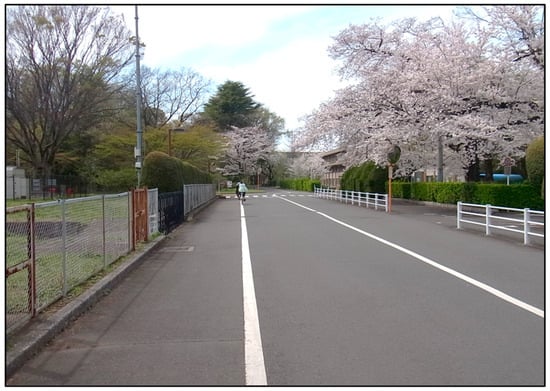
Figure 1.
Circuit road on the campus of International Christian University. The road is paved with asphalt.
The weight of each shoe, measured before walking for 7 laps (14.7 km), 14 laps (29.4 km), 24 laps (50.4 km), and 44 laps (92.4 km), was determined using an electronic balance (GF-603A, A & D Automotive Engineering and Technologies, Tokyo, Japan) at up to two decimal places. To measure the weights of the shoes after walking, stones and soil attached to the shoe outsoles were removed using forceps and brushes and then kept in a dryer (55 °C) for 120 min to evaporate sweat present in the shoes. The mean weights of the shoes at each lap were analyzed using a two-way repeated-measures ANOVA and Bonferroni’s post hoc multiple-comparison test.
We also purchased another three pairs of walking shoes (Company A, B, and C) as control shoes. We examined whether shoe weight changed by aging with six shoes. The mean weight and SD of each shoe are 286.01 ± 38.44 g (N = 6). Since it took almost two years to complete five walking tests in this experiment, we kept the control shoes for two years at 25 °C in the same place in the laboratory where experimental shoes were kept when they were not used for the walking tests. Both experimental shoes and control shoes were subjected to the same environmental conditions, such as humidity changes in the laboratory. The control shoes underwent drying treatment four times, as did the experimental shoes.
The weights of the control shoes were measured before and after the five experimental tests, and these weights were compared using a paired t-test. The mean weights of the control shoes (N = 6) and experimental shoes (N = 10) before and after the five tests were compared using Welch’s t-test.
2.3. Experiment 2 (Relationship Between Walking or Jogging and Shoe Weight)
In this experiment, we compared the decreases in shoe weight between walking and jogging. We purchased two pairs of “running shoes” of the same model from five different companies (Company A, D, F, G, and H) for each of the five volunteer participants. The weights of the pairs of shoes were as follows: Company A, 398.76 g (W, for walking) and 399.80 g (J, for jogging); Company D, 606.66 g (W) and 611.92 g (J); Company F, 590.39 g (W) and 574.80 g (J); Company G, 368.38 g (W) and 365.79 g (J); Company H, 380.86 g (W) and 369.31 g (J). The outsoles of “running shoes” and “walking shoes” have different properties. Running shoes have thick and stiff soles to provide a cushion against the impact of steps. Walking shoes have thin and flexed soles and are designed more for comfort than for performance [,]. In the experiment, running shoes were used for both walking and jogging. Moreover, the experiment was conducted on a university circuit road in ICU.
Five volunteer participants were asked to walk one lap using a pair of shoes and then jog one lap using another pair of shoes of the same model on the same day. Each participant walked 44 laps and jogged 44 laps on the university circuit road. Walking and jogging tests were conducted on non-rainy days when the road was dry. The walking and jogging speeds were 4.6–5.1 km/h and 6.5–9.0 km/h, respectively, and the body weights of the five participants were 41.0, 59.0, 65.0, 67.0, and 68.0 kg, respectively. The chemical compositions of the shoe outsoles were not determined. Shoe weights were measured in the same manner as in Experiment 1. Comparisons of the mean shoe weights across the four laps and between walking and jogging at each lap were analyzed using two-way repeated-measures ANOVA and Bonferroni’s post hoc multiple-comparison test.
The study was conducted according to the guidelines of the Declaration of Helsinki and approved by the Ethics Committee of International Christian University (Case 2023–37, approved on 29 February 2024).
2.4. Experiment 3 (MP Release from Shoe Outsoles Under Simulated Conditions of Shoes and a Road Using Sandpaper and a Laboratory Shaker)
It was confirmed that the weights of the shoes decreased when walking or jogging. The decrease in shoe weight was speculated to be caused by the abrasion of shoe outsoles on the asphalt road and by the release of rubber particles. However, there are no reports on the abrasion and release of shoe outsoles. We conducted experiments on shoe abrasion and release under simulated shoe and asphalt road conditions using sandpaper and a laboratory shaker.
Sandpaper of coarse grade (#40, the coarsest grade commercially available in Japan, 23 × 28 cm; Takagi, Niigata, Japan) that imitated the surface of an asphalt road was attached to the table of a laboratory shaker (table size, 24 × 24 cm; SK-L180-Pro, As One, Osaka, Japan) (Figure 2). One shoe was placed on sandpaper and fixed using metal plates and a rubber band. A weight of 500 g (Ankle & wrist weight for physical training, Daiso, Hiroshima, Japan) was placed in the shoe so that the shoe could have stronger contact with the sandpaper. The contact of the shoes to the paper was weak without the weight, and a heavier weight inhibited the movement of the shaker in our preliminary tests. The table and sandpaper moved 4 mm reciprocally, causing friction between the shoe outsoles and the sandpaper. The speed and time of movement of the shaker were set to 100 and 300 reciprocal motion per minute (rmpm; the maximum speed of the shaker was 350 rmpm) for 3 min. When the test period was shorter than 3 min, the data variability was large, and when the test period was longer than 3 min, the particle density on the sandpaper became high, making it difficult to count the number of rubber particles in our preliminary tests.
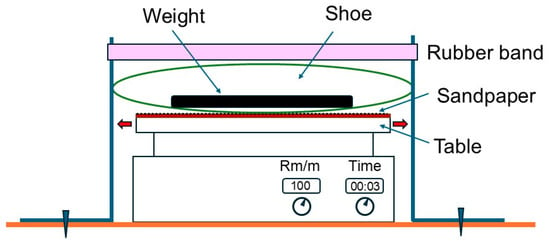
Figure 2.
Experimental apparatus used for the abrasion test under simulated conditions of a road and shoes. A shoe was set on sandpaper and fixed using metal holders and a rubber band. A weight (500 g) was placed in the shoe to ensure stronger contact between the shoe and sandpaper. The sandpaper attached to the table of a laboratory shaker moved 4 mm reciprocally, causing friction between the shoe and sandpaper. Red arrows indicate the direction of the movement of the table. Rm/m, reciprocal motion per minute.
Three pairs of running shoes were obtained for this experiment (Company I, J, and K). The weights of the pairs of shoes were 623.7, 831.2, and 934.7 g, respectively. In addition, they had green color (Company I and J) or purple color (Company K) outsoles. The experimental shoes were subjected to several priming tests at 300 Rm/m on sandpaper to increase the area of contact between the outsoles and sandpaper. Each shoe was tested on sandpaper at 100 and 300 Rm/m for 3 min. The abrasion test was repeated twice using one shoe from each of the three companies, and the average number was presented in the results.
After each test, the sandpaper was replaced with a new one. After the test, several colored patches of the shoe outsoles were observed on the sandpaper. The patches consisted of abraded particles of the shoe outsoles. Photographs of the patches were captured using a camera (WG-30, Ricoh, Tokyo, Japan). Moreover, each photograph was printed, and enlarged copies were made. Using the enlarged copies, the number of colored particles on the sandpaper was counted with the naked eye. The abrasion particles of the shoe outsoles were distinguished from other sandpaper particles by their color. Because there were various particle shapes on the sandpaper, we did not measure the size (length) of the particles, and the weights of the particles could not be measured because of their small size. The validation of visual counting was determined by calculating coefficient of variation (CV) which is commonly used for the confirmation of precision of measurement methods in science and technology. We selected three enlarged photographs from each shoe test (I-300, J-300, K-300) and made five copies of each photograph. We counted the number of abrasion particles using the five copies. We calculated mean value and standard deviation, and CV (N = 5) for the three cases. Coefficients of variation in the three cases were 2.8, 1.1, and 2.1%, for I-300, J-300, and K-300, respectively. Since the CVs were below 10%, precision and reliability of our visual counting method was high enough.
2.5. Goldfish
A common goldfish variety, C. auratus, was obtained from a fish merchant in Saitama Prefecture, Japan. Approximately 100 fish were kept in an 800-L stock tank maintained at 20 °C under a 16-h light/8-h dark (16 L/8D) photoperiod (lights on at 06:00). The fish were fed commercial floating goldfish feed (Angel, Nippon Pet Food Co., Ltd., Tokyo, Japan) once daily. All experimental fish (mixed sex) were kept in a stock tank for over one week before use in the experiments.
All goldfish experiments conducted at International Christian University adhered to the guidelines of the Animal Experimentation Committee of International Christian University, and this study was approved by the Animal Experimentation Committee of International Christian University. When we use fishes, amphibians, invertebrates or cultured animal cells for experiments, we do not exchange documents as long as we follow the guidelines.
2.6. Preparation of RTs from Shoes and Sandals
The posterior parts of the rubber outsoles of the walking shoes (Company C) were shoved into small pieces (1–2 cm long) using a utility knife, and the pieces were cut into tips using scissors. The tips were sieved, and RTs 0.5–2.0 mm in size were selected (Figure 3a). The RTs that sank in the water were used for the ingestion experiments (Experiment 4).
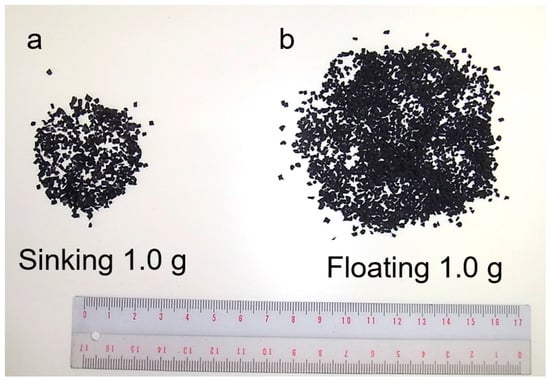
Figure 3.
Rubber tips (1.0 g) prepared from the outsoles of shoes and sandals. (a) Sinking rubber tips prepared from shoes. (b) Floating rubber tips prepared from sandals.
The posterior parts of the rubber outsoles of the sandals (Company L) were shoved into small pieces (1–2 cm long) using a utility knife, and the pieces were cut into tips using scissors. The tips were sieved, and RTs with a size of 0.5–2.0 mm were selected (Figure 3b). The RTs that floated in the water were used for ingestion experiments (Experiment 5).
2.7. Experiment 4 (Ingestion of Sinking RTs Derived from Shoe Outsoles by Goldfish)
We determined whether goldfish ingested sinking RTs from walking shoes, with or without feed. The average body weight of the goldfish used for the experiment was 29.4 ± 5.3 g (mean ± SD, N = 24). For each test, three goldfish (mixed sex) were transferred from the stock tank to the experimental 60-L glass aquarium and were given 3 days to acclimatize to the tank environment and the sinking goldfish feed (Saki-Hikari Fancy Goldfish, Kyorin, Himeji, Japan). The experimental aquaria were maintained at 20 °C under a 16 L/8D photoperiod (lights on at 06:00).
The fish were fed sinking feed (0.5 g) once daily for 3 days. On the fourth day, the experimental fish were categorized into one of three groups. Fish from the experimental groups were given a mixture of feed (0.25 g) and RTs (0.25 g) (N = 9) or only RTs (0.5 g) (N = 9). Control fish (N = 6) were fed only 0.5 g of feed. Ninety minutes after the treatment, the fish were anesthetized using 0.05% 2-phenoxyethanol (Wako Pure Chemical Industries, Ltd., Osaka, Japan) and dissected. The intestine was examined to determine whether RTs were ingested. The RTs observed in the intestine of each fish were collected and counted. The number of ingested RTs was compared among the three groups, with the significance of the differences among groups compared using the Kruskal–Wallis and Steel–Dwass tests.
2.8. Experiment 5 (Ingestion of Floating RTs Derived from Sandal Outsoles by Goldfish)
We assessed whether goldish ingested floating RTs from sandals. The average body weight of the goldfish used for the experiment was 28.0 ± 4.9 g (mean ± SD, N = 24). For each test, three fish (mixed sex) were transferred from the stock tank to the experimental 60-L glass aquarium and were given 3 days to acclimatize to the tank environment and floating goldfish feed (Comet, Goldfish Feed, Itosui, Tokyo, Japan). The experimental aquaria were maintained at 20 °C under a 16 L/8D photoperiod (lights on at 06:00).
The fish were fed floating feed (0.5 g) once daily for 3 days, and on the fourth day, they were categorized into three groups. Fish from the experimental groups were fed a mixture of feed (0.25 g) and RTs (0.25 g) (N = 9) or only RTs (0.5 g) (N = 9). Control fish (N = 6) were fed only 0.5 g of feed. Ninety minutes after the treatment, the fish were treated as described in Experiment 4. The number of ingested RTs was compared among the three groups, and the Kruskal–Wallis and Steel–Dwass tests were used to compare the significance of the differences among groups.
3. Results
3.1. Experiment 1 (Relationship Between Walking Distance and Shoe Weight)
The weights of all experimental shoes (N = 10) decreased after 7, 14, 24, and 44 laps of walking (92.4 km), compared to the weights before walking, and the weights of the shoes at each lap were significantly lower than those of the previous laps (laps: 0 vs. 7, p < 0.05; 0 vs. 14; 0 vs. 24; 0 vs. 44, p < 0.001: 7 vs. 14; 7 vs. 24, p < 0.01; 7 vs. 44, p < 0.001: 14 vs. 24, p < 0.05; 14 vs. 44, p < 0.001: 24 vs. 44, p < 0.01) (Figure 4). The outsoles of the experimental shoes appeared to be abraded after walking.
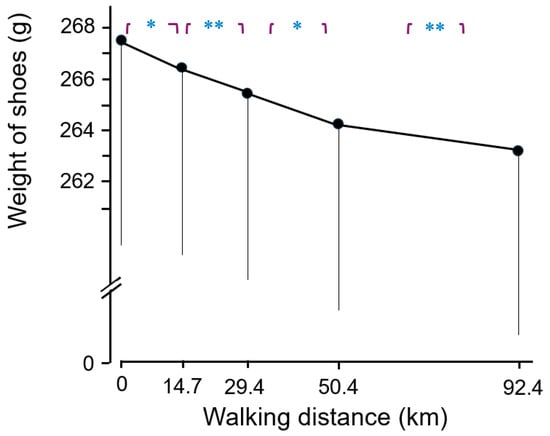
Figure 4.
Relationship between walking distance and shoe weight (Experiment 1). Symbols and bars indicate the mean and the SEM, respectively (N = 10). The mean weights of the shoes at each lap were significantly lower than those of the previous laps (* p < 0.05; ** p < 0.01).
The weight of controls shoes (N = 6) before and the after the five tests were 286.01 ± 38.44 g (mean ± SD, N = 6) and 285.54 ± 38.44 g, and there was a significant decrease in the weights of the control shoes over a two-year period (p < 0.05). The weights of the experimental shoes (267.38 ± 29.97 g) and the control shoes (286.01 ± 38.44 g) were not significantly different before the tests (p > 0.05); however, the weight of the experimental shoes (263.15 ± 29.70 g) was significantly lower than that of the control shoes (285.54 ± 38.44 g) after the five tests (p < 0.05). By conducting this experiment, we released 42.9 g of MPs into the environment.
3.2. Experiment 2 (Relationship Between Walking or Jogging and Shoe Weight)
The shoe weight decreased after 44 laps of both walking and jogging (Figure 5). Additionally, the weights of shoes at 7, 14, 24, and 44 laps of walking (90.2 km) were significantly lower than those before use, and the weights of the shoes at each lap were significantly lower than those of the previous laps for walking (laps: 0 vs. 7, p < 0.05, 0 vs. 14, 0 vs. 24, 0 vs. 44, p < 0.001; 7 vs. 14, 7 vs. 24, 7 vs. 44, p < 0.001; 14 vs. 24, 14 vs. 44, p < 0.001; 24 vs. 44, p < 0.001) and jogging (laps: 0 vs. 7, p < 0.01, 0 vs. 14, 0 vs. 24, 0 vs. 44, p < 0.001; 7 vs. 14, 7 vs. 24, 7 vs. 44, p < 0.001; 14 vs. 24, 14 vs. 44, p < 0.001; 24 vs. 44, p < 0.001) (Figure 5). At 0, 7, 14, 24, and 44 laps, there were no differences in the weights of the shoes between walking and jogging (p > 0.05), indicating that the rate of decrease in the shoe weight between walking and jogging did not differ.
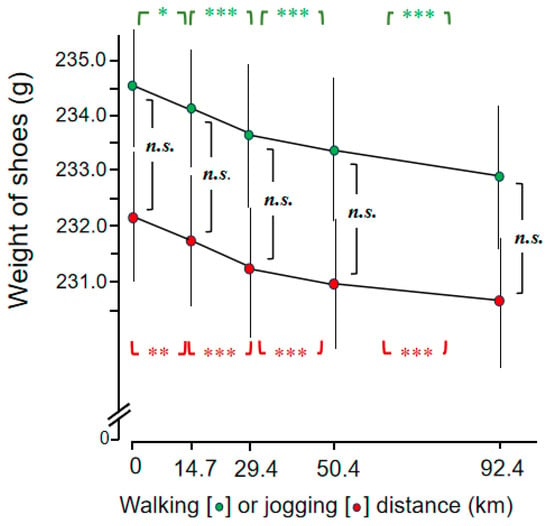
Figure 5.
Relationships between walking or jogging distance and shoe weight (Experiment 2). Symbols and bars indicate the mean and the SEM, respectively (N = 10). The mean weights of the shoes at each lap were significantly lower than those of the previous laps (* p < 0.05, ** p < 0.01, *** p < 0.001). n.s., not significant.
The outsoles of the experimental shoes showed an abraded appearance after walking or jogging. Some shoes contained fragments on their outsoles. A long fragment was observed on an outsole after walking and was detached with further walking (Figure 6 and Figure 7). By conducting this experiment, we released 32.6 g of MPs into the environment.

Figure 6.
Fragments made on the outsoles of shoes after walking in Experiment 2. (a) Some fragments (blue-colored arrows) were observed on the anterior parts of the outsoles after walking for 84.0 km (40 laps). (b) Close-up photograph of fragments (blue-colored arrows) on the outsoles after 84.0 km (40 laps) (different part of outsole from that shown in photograph (a)). (c) A long fragment (red-colored arrow) was observed after walking for 90.3 km (43 laps). Some short fragments were observed (blue-colored arrows). (d) After further walking (92.4 km, 44 laps), the long fragment shown in photograph (c) was detached at 92.4 km (44 laps) (indicated by a red-colored arrow). Short fragments remained on the outsole (blue-colored arrows).
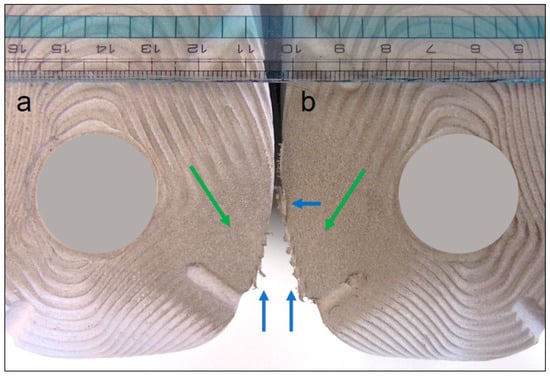
Figure 7.
Abrasion of posterior parts of outsoles after walking or jogging in Experiment 2. (a) Posterior part of abraded outsoles after walking (at 92.4 km, 44 laps) (b) Posterior part of abraded outsoles after jogging (at 92.4 km, 44 laps). Green-colored arrows indicate abraded parts. Short and long blue-colored arrows indicate fragments made on the outsoles of shoes by walking or jogging. Grey-colored circles cover the logos of the manufacturers of the shoes.
The sample sizes of Experiments 1 and 2 were not so large, but after we conducted Experiments 1 and 2, 75.5 g of MPs from shoe outsoles were released into the environment. Therefore, we did not increase the sample size of the experiments to avoid more release of MPs from shoe outsoles from the point of view of environmental conservation.
3.3. Experiment 3 (Abrasion of Shoe Outsoles on Sandpaper)
After the abrasion tests were conducted on the shoe, colored patches were observed on the sandpaper. More patches were observed on the sandpaper at a higher movement speed (300 Rm/m) of the sandpaper than at a lower movement speed (100 Rm/m). In each patch, many abrasion particles with the same color as the shoe outsoles were observed. Comparing the shoes of the three companies, more patches were observed on the sandpaper when tested using shoe from Company I and J than when tested using those from Company K. As a result, there was a tendency that more abrasion particles were observed in the shoes of Companies I and J than in those of Company K. The number of particles was counted, as shown in Figure 8 and Figure 9. Columns of Figure 9 indicate the average of two-time tests. Less patches were observed in the shoe of Company K, and it was considered that the outsole from Company K was less flat and that the area of contact with the sandpaper, rather than the difference in the hardness of the outsole, was lower than those of the other two companies. After this experiment, the weight of shoes was measured but the decrease in the weight could not be detected with the electronic balance because of small weight of the abraded particles.
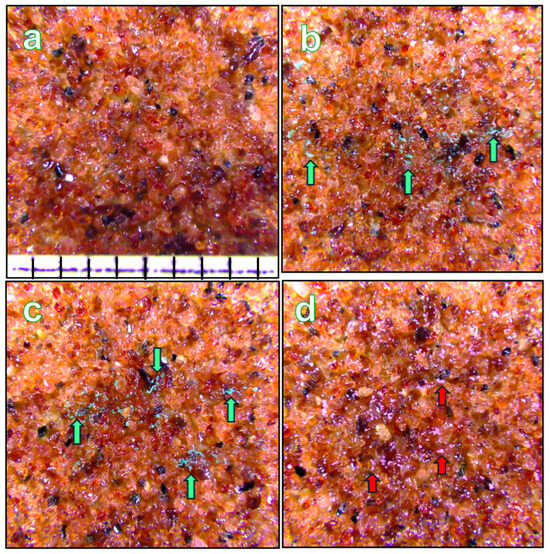
Figure 8.
Production of plastic particles via friction between shoe outsoles and sandpaper. (a) Close-up photograph of unused sandpaper. A scale indicates one millimeter. (b) Green-colored particles were observed on the sandpaper after the abrasion test with a shoe from Company I. (c) Green-colored particles were observed after the abrasion test with a shoe from Company J. (d) Purple-colored particles were observed after the abrasion test with a shoe from Company K. Green and red arrows indicate green color plastic particles and purple color plastic particles, respectively produced from shoe outsole by abrasion. The magnification is the same for all photographs.
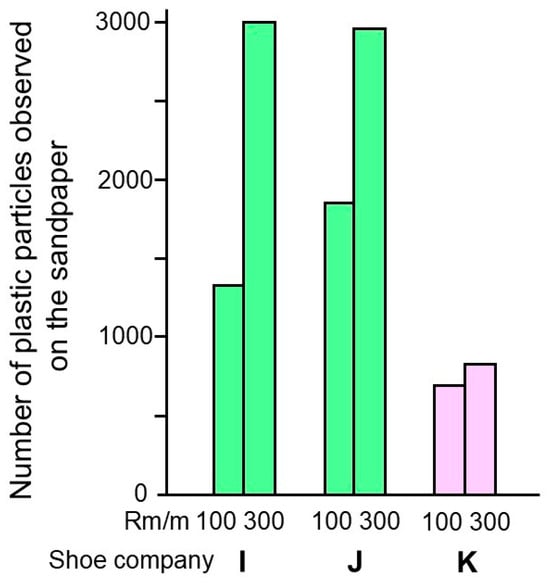
Figure 9.
Number of abrasion particles found after abrasion tests with shoes from Company I, J, and K. Friction between the sandpaper and shoes was caused via reciprocal motion of the sandpaper on the laboratory shaker, using the apparatus shown in Figure 2. The shaker moved reciprocally at 100 or 300 Rm/m (reciprocal motion per minute) for 3 min. After each abrasion test, the number of particles on the sandpaper were counted. Green-colored columns indicate the number of particles from shoes of Company I and J. The purple-colored column indicates the number of particles from shoes of Company K. Columns indicate the average of two-time tests (N = 2).
3.4. Experiment 4 (Ingestion of Sinking RTs Derived from Shoe Outsoles by Goldfish)
Goldfish ingested sinking RTs from shoe outsoles with or without feed (Figure 10 and Figure 11). The number of ingested RTs was significantly higher in the group given a mixture of feed and RTs than in the control group (p < 0.05).
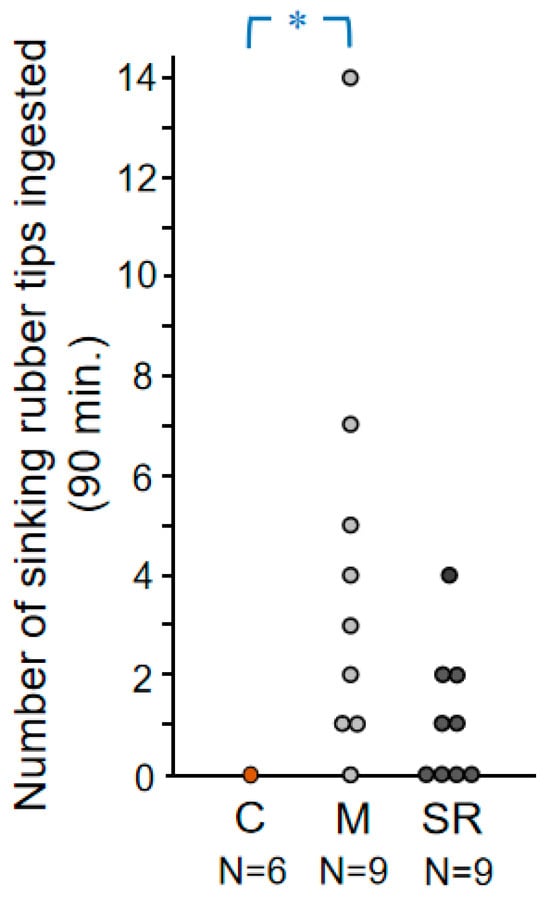
Figure 10.
Ingestion of sinking RTs from shoe outsoles by goldfish. Fish were divided into three groups and given one of three materials: C, fish feed (control); M, mixture of fish feed and RTs (group M); SR, only sinking RTs (group SR). * C vs. M, p < 0.05.
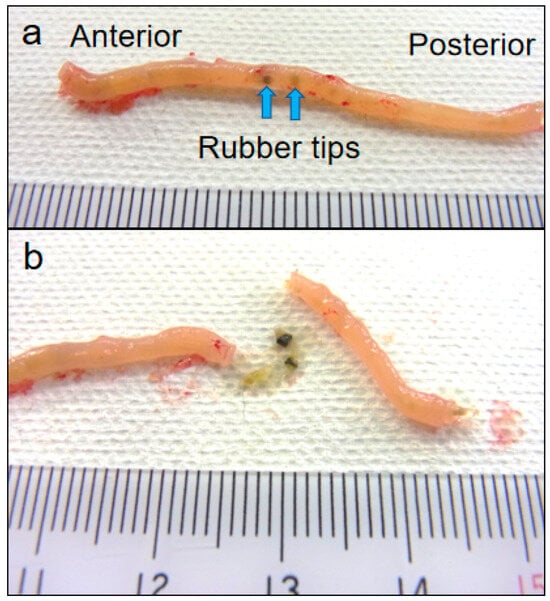
Figure 11.
Ingestion of sinking RTs by goldfish. (a) Ingested RTs in the lumen of the intestines of the goldfish (arrows). (b) Two pieces of RTs were collected by cutting the intestines. Photographs were taken from fish of the SR group.
3.5. Experiment 5 (Ingestion of Floating RTs Derived from Sandal Outsoles by Goldfish)
Goldfish ingested floating RTs from sandal outsoles with or without feed (Figure 12). The numbers of ingested RTs in the group given a mixture of feed and RTs (p < 0.05) and in the group given only RTs (p < 0.05) significantly exceeded that of the control group.
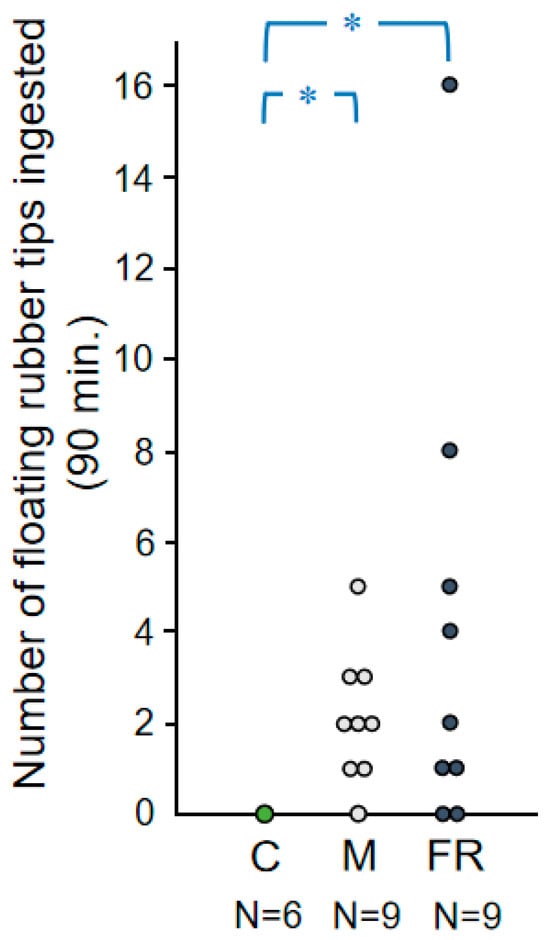
Figure 12.
Ingestion of floating RTs of sandal outsoles by goldfish. Fish were divided into three groups and given one of three materials: C, fish feed (control); M, mixture of fish feed and RTs (group M); FR, only floating RTs (group FR). * C vs. M, p < 0.05; * C vs. FR, p < 0.05.
The sample sizes of Experiments 4 and 5 were not so large, but statistical significances were observed in the experiments, and we did not increase the sample size of the experiments to avoid sacrificing more fish from the point of view of animal welfare.
4. Discussion
The present study clearly showed the process by which shoe outsoles produce and release MPs via abrasion. This study also demonstrated the ingestion of MPs derived from shoe outsoles by fish. Worn-out shoes are commonly replaced with a new pair, which means that MPs are released from shoes during walking, jogging, or running if the shoe outsoles are composed of synthetic materials. Our experiments showed that, with increases in the moving distance, the weights of shoes decreased. This decrease was mainly caused by abrasion of the outsoles, not by aging. In Experiment 1, the weight of the control shoes decreased slightly, and this decrease was considered to occur due to the drying treatments rather than aging. It has been reported that the moisture in plastics evaporates via heat drying [,,].
Interestingly, the rates of decrease in shoe weight between walking and jogging were not significantly different in Experiment 2. Although the impact of shoes on the road at each step seemed to be much higher in jogging than in walking, the rates of decrease in shoe weight did not differ significantly at each lap. This phenomenon can be explained by the difference in the number of steps required between walking and jogging. The slide length during jogging is approximately 1.5 times longer than that during walking []. This difference results in a difference in the number of steps taken over the same distance. The number of steps taken by jogging was estimated to be approximately 66.6% that of walking in Experiment 2. However, in both cases, the shoe outsoles were abraded and released MPs into the environment. The MPs then migrate into aquatic environments via wind and rain [,].
A comparison of the results for walking shoes and running shoes between Experiments 1 and 2 revealed that the decrease in the weight of walking shoes was larger than that of running shoes after they were used for walking the same distance. A pair of walking shoes lost approximately 8.6 g, whereas a pair of running shoes lost approximately 3.3 g after a 92.4-km walk. This difference might have been due to the different characteristics of the outsoles of walking and running shoes. Running shoes are designed with durable outsoles that withstand the impact of each step on roads, whereas walking shoes are designed with soft and flexible outsoles that are comfortable for long-distance walking [,]. Therefore, the outsoles of walking shoes are more easily abraded than those of running shoes.
Although we found a decrease in the weight of shoes after walking or jogging on the road and the abrasion of shoe outsoles, we did not observe or confirm whether the abraded debris or abraded particles were released on the road. To clarify the process of releasing MPs from shoe outsoles, we used sandpaper in an experiment to clarify how MPs are released from shoe outsoles under simulated conditions of a road and shoes. After creating friction between the shoe outsoles and the sandpaper, many particles were observed on the sandpaper. Although our system did not completely reflect the relationships between shoes and road surface, this is a clear experimental demonstration of production of MPs from shoe outsoles via friction force. There are some experimental studies which showed friction between shoe outsoles and surface materials [,,]. However, these studies focused on shoe outsole or surface conditions and did not consider environmental pollution caused with shoe abrasion debris.
Some other studies dealt with shoe outsole fragments as microplastics, but samples of shoe outsole particles were obtained by manual scrubbing using file under uncertain conditions [,] or maceration in liquid nitrogen in these studies []. It is clear that shoe outsole abrasion occurs by friction force between shoe outsole and surface materials.as shown in Experiments 1, 2, and 3. The abrasion rate might vary depending on the surface material of the road, such as asphalt, concrete, cobblestone, flagstone, etc.
From the observations in Experiments 1, 2, and 3, the abrasion of the shoe outsoles produced abrasion debris (fragments) and abrasion particles. In addition, these experiments showed a tendency that the greater the friction, the more particles were produced from the shoe outsoles. The abraded particles would be released into the environment as MP, first on the road and in the air, after which the MPs would migrate into the aquatic environment via rain and wind [,]. In the present study, only debris and particles of visible sizes were observed, and it was possible that much smaller nano-size particles floated in the air when using modern footwear to walk or jog on the road.
Our study also demonstrated the ingestion of MPs originating from footwear outsoles by fish. Goldfish intentionally ingested both sinking and floating RTs with or without feed. These results indicate that the goldfish recognized the RTs as food. These results suggest that wild and aquaculture fishes ingest MPs originating from shoe outsoles and that the MPs cause negative effects on fish health, such as gut damage, oxidative stress, behavioral changes [,,]. Additionally, the toxicity of MPs of shoe origin has been reported for plants, green algae, crustaceans, fish embryos, and amphibian larva [,,], resulting in changes in aquatic ecosystem. It has also been reported that MPs in marine environments sorb and accumulate organic pollutants from seawater and that these pollutants may cause toxicity in the digestive tracts of marine animals [].
Since footwear is used in everyday life, professional work, and sports, and they are mostly made using synthetic materials. Therefore, stopping the release of MPs from footwear and recovering the released MPs will remain difficult as long as footwear made with synthetic materials is used. Although the amount of MPs released from a pair of shoes is small, shoes are used worldwide. There is a controversial point in the research field because we released 75.5 g of MPs into the environment by our present study (Experiments 1 and 2) for the study of reduction in MP release. Experimental design would be important to minimize the release of MPs during experiments by making small scale experiments which give paired data, not independent data to obtain more reliability with small sample size, or by making other designs of experiments, such as simulated conditions in the laboratory. Our study showed that the releasing rate of MPs of a pair of running shoes was 35 mg/km by walking or jogging (walking shoes, 90 mg/km by walking). This rate is not so small compared to other cases. Vehicles release 52–82 mg/km/1000 kg vehicle of tire wear, and mountain bike releases 36 mg/km of MP into the environment by abrasion [,,]. When we think of annual production of shoes (22 billion pairs per year) [], some measures should be conducted to prevent release of MPs from shoes.
Based on our experiments, a pair of running shoes releases 35 mg of MPs per kilometer of running, which may provide an estimate. In the Olympic Marathon held in Tokyo in 2021, 75 male athletes and 73 female athletes ran for 42.195 km, which produced 218 g of MPs [,]. In the “Tokyo Marathon 2024” held in Tokyo in 2024, 35,443 athletes ran for 42.195 km, which released 52.3 kg of MPs []. Therefore, the quantity of MPs released by road runners is not negligible.
One measure for reducing the release of MPs from footwear is the replacement of synthetic materials with biodegradable materials when making footwear. Several companies produce and sell shoes made of biodegradable materials [,,,,,,,,], and more companies are expected to produce biodegradable footwear. Meanwhile, it is important to inform the general public, athletes, and Sports Scientists that MPs are released into the environment not only from shoes but also from some sports facilities [,,,,,].
5. Conclusions
The present study demonstrated the process of the release of MPs from shoe outsoles and the ingestion of MPs of shoe outsole origin by fish. MPs from shoe outsoles are first released on roads and possibly in the air, after which they migrate into aquatic environments via rain and wind. Wild and aquaculture fishes may ingest MPs of shoe outsole origin, which have negative effects on their health. To reduce the amount of MPs released from shoes, natural or biodegradable materials, rather than synthetic or non-biodegradable materials, should be used to produce shoes. It is also important to inform the general public, athletes, and Sports Scientists that MPs are released from shoes into the environment.
Author Contributions
Conceptualization: M.K.; methodology, S.M., M.K. and Y.S.; formal analysis; Y.S.; writing—original draft preparation, M.K.; review and editing, R.F., T.Y. and Y.S.; visualization, M.K.; project administration, M.K.; funding acquisition, M.K. All authors have read and agreed to the published version of the manuscript.
Funding
This work was supported in part by Japan Society for the Promotion of Science (Grant Number 24K05503) and International Christian University (Grant Number AY2022-NS-BIO-001).
Institutional Review Board Statement
Experiments 1 and 2 of the present study were conducted in accordance with the Declaration of Helsinki and approved by the Ethics Committee of International Christian University (Case 2023–37, 29 February 2024). All goldfish experiments (Experiments 4 and 5) were conducted at International Christian University. Japanese Government, Ministry of Education, Culture, Sports, Science, and Technology set guidelines for animal experiments in 2006 (https://jes1950.jp/Download2/hoi1-10th-E-monkashou.pdf (accessed on 20 October 2025)). This guideline is applied to the cases when mammals, birds, and reptiles are used for experiments, and amphibians, fishes, invertebrates, and culture cells are not the case. The Animal Experimentation Committee of International Christian University follows the governmental guidelines. When we use fish for experiments, we are allowed to use fish without submitting notification to the University Committee. Therefore, we are approved to conduct experiments using fish in accordance with the Governmental and University Guideline.
Data Availability Statement
The data presented in this study is available on request from the corresponding author. The data are not publicly available due to their large sample size.
Acknowledgments
We thank participants for walking experiments and jogging experiments.
Conflicts of Interest
The authors declare no conflicts of interest.
Abbreviations
| MP | Microplastic |
| RT | rubber tip |
| rmpm | reciprocal motion per minute |
| ICU | International Christian University |
References
- Albazoni, H.J.; Al-Haidarey, M.J.S.; Nasir, A.S. A Review of Microplastic Pollution: Harmful Effect on Environment and Animals, Remediation Strategies. J. Ecol. Eng. 2024, 25, 140–157. [Google Scholar] [CrossRef]
- Thacharodi, A.; Meenatchi, R.; Hassan, S.; Hussain, N.; Bhat, M.J.; Arockiaraj, J.; Ngo, H.H.; Le, Q.H.; Pugazhendhi, A. Microplastics in the environment: A critical overview on its fate, toxicity, implications, management, and bioremediation strategies. J. Environ. Manag. 2024, 349, 119433. [Google Scholar] [CrossRef] [PubMed]
- Vazquez-Rowe, I.; Ita-Nagy, D.; Kahhat, R. Microplastics in fisheries and aquaculture: Implication to food sustainability and safety. Curr. Opin. Green Sustain. Chem. 2021, 29, 100464. [Google Scholar] [CrossRef]
- Ziani, K.; Ionita-Mindrican, C.B.; Mititelu, M.; Neacsu, S.M.; Negrei, C.; Morosan, E.; Draganescu, D.; Preda, O.T. Microplastics: A real global threat for environmental and food safety: A state of the art review. Nutrients 2023, 15, 617. [Google Scholar] [CrossRef]
- Arat, S.A. An overview of microplastic in marine waters: Sources, abundance, characteristics and negative effects on various marine organisms. Desalination Water Treat. 2024, 317, 100138. [Google Scholar] [CrossRef]
- Bhardwaj, L.K.; Rath, P.; Yadav, P.; Gupta, U. Microplastic contamination, an emerging threat to the freshwater environment: A systematic review. Environ. Syst. Res. 2024, 13, 8. [Google Scholar] [CrossRef]
- Mistri, M.; Sfriso, A.A.; Casoni, E.; Nicoli, M.; Vaccaro, C.; Munari, C. Microplastic accumulation in commercial fish from the Adriatic Sea. Mar. Pollut. Bull. 2022, 174, 113279. [Google Scholar] [CrossRef]
- Bhatia, S.K.; Kumar, G.; Yang, Y.H. Understanding microplastic pollution: Tracing the footprints and eco-friendly solutions. Sci. Total Environ. 2024, 914, 169926. [Google Scholar] [CrossRef] [PubMed]
- Razaviarani, V.; Saudagar, A.; Gallage, S.; Shrinath, S.; Arab, G. Comprehensive investigation on microplastics from source to sink. Clean Technol. Environ. Policy 2024, 26, 1755–1782. [Google Scholar] [CrossRef]
- Evans, N. Sports and leisure infrastructure and applications: Styrene butadiene crumb rubber infill in artificial turf sports fields. In Tyre Waste and Recycling; Letcher, T.M., Shulman, V.L., Amirkhanian, S., Eds.; Elsevier: Amsterdam, The Netherland, 2021; pp. 483–497. [Google Scholar]
- Luo, Z.; Zhou, X.; Su, Y.; Wang, H.; Yu, R.; Zhou, S.; Xu, E.G.; Xing, B. Environmental occurrence, fate, impact, and potential solution of tire microplastics: Similarities and differences with tire wear particles. Sci. Total Environ. 2021, 795, 148902. [Google Scholar] [CrossRef]
- Verschoor, A.J.; van Gelderen, A.; Hofsrra, U. Fate of recycled tyre granulate used on artificial turf. Environ. Sci. Eur. 2021, 33, 27. [Google Scholar] [CrossRef]
- Chiba, R.; Fujinuma, R.; Yoshitomi, T.; Shimizu, Y.; Kobayashi, M. Ingestion of rubber tips of artificial turf fields by goldfish. Sci. Rep. 2023, 13, 1334. [Google Scholar] [CrossRef]
- Kobayashi, M.; Chiba, R.; Takahashi, K.; Takemasa, J.; Fujinuma, R.; Shimizu, Y.; Yoshitomi, T. Ingestion of rubber tips of artificial sports fields by rainbow trout. J. Kanagawa Sport Health Sci. 2023, 56, 13–25, (In Japanese with English Abstract). [Google Scholar] [CrossRef]
- Giechaskiel, B.; Grigoratos, T.; Mathissen, M.; Quik, J.; Tromp, P.; Gustafsson, M.; Franco, V.; Dilara, P. Contribution of Road vehicle tyre wear to microplastics and ambient air pollution. Sustainability 2024, 16, 522. [Google Scholar] [CrossRef]
- Sommer, F.; Brockman, L.; Steinbauer, M.J.; Audorff, V. Quantifying abrasion of microplastics from mountain bike tires. Sci. Total Environ. 2025, 969, 178971. [Google Scholar] [CrossRef]
- Swallow, A. The history of shoes. Bailliere’s Clin. Rheumatol. 1987, 1, 413–429. [Google Scholar] [CrossRef] [PubMed]
- Peacock, J. Shoes: The Complete Sourcebook; Thames and Hudson, Ltd.: London, UK, 2005. [Google Scholar]
- Shawcross, R. Shoes: An Illustrated History; Bloomsbury: Bedford Square, UK, 2023. [Google Scholar]
- F-WORKS WEB. Shoes of the World 2022 Edition. Available online: https://www.f-works.com/fwp/fwpbn/22-09/pick5.html (accessed on 14 January 2024).
- Forster, N.A.; Wilson, S.C.; Tighe, M.K. Microplastic pollution on hiking and running trails in Australian protected environments. Sci. Total Environ. 2023, 874, 162473. [Google Scholar] [CrossRef]
- Forster, N.A.; Wilson, S.C.; Tighe, M.K. Trail running events contribute microplastic pollution to conservation and wilderness areas. J. Environ. Manag. 2023, 331, 117304. [Google Scholar] [CrossRef]
- Lee, T.; Kim, L.; Kim, D.; An, S.; An, Y. Microplastics from shoe sole fragments cause oxidative stress in a plant (Vigna radiata) and impair soil environment. J. Hazard. Mater. 2022, 429, 128306. [Google Scholar] [CrossRef]
- Kim, L.; Kim, D.; Kim, S.A.; Kim, H.; Lee, T.; An, Y. Are your shoes safe for the environment?—Toxicity screening of leachates from microplastic fragments of shoe soles using freshwater organisms. J. Hazard. Mater. 2022, 421, 126779. [Google Scholar] [CrossRef]
- da Costa Araujo, A.P.; da Luz, T.M.; de Oliveira Goncalves, S.; Rajagopal, R.; Rahaman, M.M.; de Melo e Silva, D.; Malafaia, G. How Can “My Shoes” Affect the Amphibian Health? A Study of the Toxicity of Microplastics from Shoe Sole on Physalaemus cuvieri Tadpoles (Anura, Leptodactylidae). J. Hazard. Mater. 2022, 440, 179847. [Google Scholar] [CrossRef]
- Kuwano, H. A study on historical process of sports equipment in Japan, Running shoes and walking shoes. Bull. Kyushu Institute Inform. Sci. 2010, 12, 83–91. (In Japanese) [Google Scholar]
- Harano, K. Running shoe function design corresponding to users’ purposes and skills. Nippon Gomu Kyokaishi 2017, 90, 433–438, (In Japanese with English Abstract). [Google Scholar] [CrossRef]
- Ji-Horng Plastic Co., Ltd. Plastic Material: Moisture and Absorption. Available online: https://www.ji-horng.com/plastic-material-moisture-absorption (accessed on 17 April 2024).
- Ji-Horng Plastic Co., Ltd. Plastic Material: Drying Temperature & Processing Time. Available online: https://www.ji-horng.com/plastic-material-drying-temperature-lead-time (accessed on 17 April 2024).
- Baschek, G.; Hartwig, G.; Zahradnik, F. Effect of water absorption in polymers at low and high temperature. Polymer 1999, 40, 3433–3441. [Google Scholar] [CrossRef]
- Barreira, T.V.; Rowe, D.A.; Kang, M. Parameters of walking and jogging in healthy young adults. Int. J. Exerc. Sci. 2010, 3, 4–13. [Google Scholar] [CrossRef]
- Sridharan, S.; Kumar, M.; Singh, L.; Bolan, N.; Saha, M. Microplastics as an emerging source of particulate air pollution: A critical review. J. Hazard. Mater. 2021, 418, 126245. [Google Scholar] [CrossRef]
- O’Brien, S.; Rauert, C.; Ribeiro, F.; Okoffo, E.D.; Burrows, S.D.; O’Brien, J.W. There’s something in the air: A review of sources, prevalence and behaviour of microplastics in the atmosphere. Sci. Total Environ. 2023, 874, 162193. [Google Scholar] [CrossRef]
- Rebeda, D.; Saha, T. Current state-of-the-art review of footwear–ground friction. Friction 2024, 12, 2188–2204. [Google Scholar] [CrossRef]
- Islam, S.; Beschorner, K.; Bagheri, Z.H. Enhancing friction with additively manufactured surface-textured polymer composites. Polym. Eng. Sci. 2024, 65, 520–538. [Google Scholar] [CrossRef]
- Zurek, M.; Markusík, D.; Rebenda, D.; Kalina, L.; Hartl, M.; Vrbka, M. The Effect of Hardness and Surface Roughness of Elastomer on Friction Between Shoe Soles and Particle-Contaminated Floors. Tribol. Lett. 2025, 73, 106. [Google Scholar] [CrossRef]
- Endo, S.; Yuyama, M.; Takada, H. Desorption kinetics of hydrophobic organic contaminations from marine plastic pellets. Mar. Pollut. Bull. 2013, 74, 125–131. [Google Scholar] [CrossRef]
- ADAC. 2025. Available online: https://www.adac.de/rund-ums-fahrzeug/ausstattung-technik-zubehoer/reifen/reifenkauf/reifenabrieb-mikroplastik/ (accessed on 28 August 2025).
- Men’s Marathon Results, Olympic Games 2021. Available online: https://www.olympics.com/ja/olympic-games/tokyo-2020/results/athletics/men-s-marathon (accessed on 3 April 2025).
- Women’s Marathon Results, Olympic Games 2021. Available online: https://www.olympics.com/ja/olympic-games/tokyo-2020/results/athletics/women-s-marathon (accessed on 3 April 2025).
- Tokyo Marathon. Available online: https://www.marathon.tokyo/about/past/2024/ (accessed on 3 April 2025).
- Blueview. Available online: https://blueviewfootwear.com (accessed on 29 March 2025).
- 8000Kicks. Available online: https://www.8000kicks.com/pages/sustainable-shoes (accessed on 29 March 2025).
- Ekn. Available online: https://www.eknfootwear.com/en/ (accessed on 29 March 2025).
- Native. Available online: https://www.nativeshoes.com/the-plant-shoe/the-plant-shoe.html (accessed on 29 March 2025).
- OAT Shoes. Available online: https://www.oatshoes.com (accessed on 29 March 2025).
- Orba. Available online: https://orbashoes.eco (accessed on 29 March 2025).
- Reebok. Available online: https://www.matrec.com/en/trends-news/reebok-collection-of-shoes-entirely-from-materials-of-vegetable-origin (accessed on 29 March 2025).
- Saucony. Available online: https://saucony.dk/biodegradable-for-good/ (accessed on 29 March 2025).
- Will’s Vegan Store. Available online: https://www.wills-vegan-store.com/ (accessed on 29 March 2025).
- Takahashi, K.; Fujinuma, R.; Yoshitomi, T.; Shimizu, Y.; Kobayashi, M. Migration of artificial turf fibers from artificial turf sports field and their ingestion by goldfish. Environments 2023, 10, 222. [Google Scholar] [CrossRef]
- Kobayashi, M.; Takemasa, J.; Fujinuma, R.; Yoshitomi, T.; Shimizu, Y. Development of a device to prevent the release of microplastics from artificial turf sports field into the natural environment. J. Kanagawa Sport. Health Sci. 2024, 57, 17–47, (In Japanese with English Abstract). [Google Scholar] [CrossRef]
- Kobayashi, M. Microplastic release from sand-filled artificial-grass tennis court and development of a device to prevent the release of synthetic grass into the environment. J. Kanagawa Sport. Health Sci. 2024, 58, 15–28, (In Japanese with English Abstract). [Google Scholar] [CrossRef]
- Senkura, U.; Shimizu, Y.; Kobayashi, M. Transfer of artificial turf fibers and rubber tips of artificial turf sports field by players from the field into the environment. J. Kanagawa Sport. Health Sci. 2024, 58, 43–57, (In Japanese with English Abstract). [Google Scholar] [CrossRef]
Disclaimer/Publisher’s Note: The statements, opinions and data contained in all publications are solely those of the individual author(s) and contributor(s) and not of MDPI and/or the editor(s). MDPI and/or the editor(s) disclaim responsibility for any injury to people or property resulting from any ideas, methods, instructions or products referred to in the content. |
© 2025 by the authors. Licensee MDPI, Basel, Switzerland. This article is an open access article distributed under the terms and conditions of the Creative Commons Attribution (CC BY) license (https://creativecommons.org/licenses/by/4.0/).